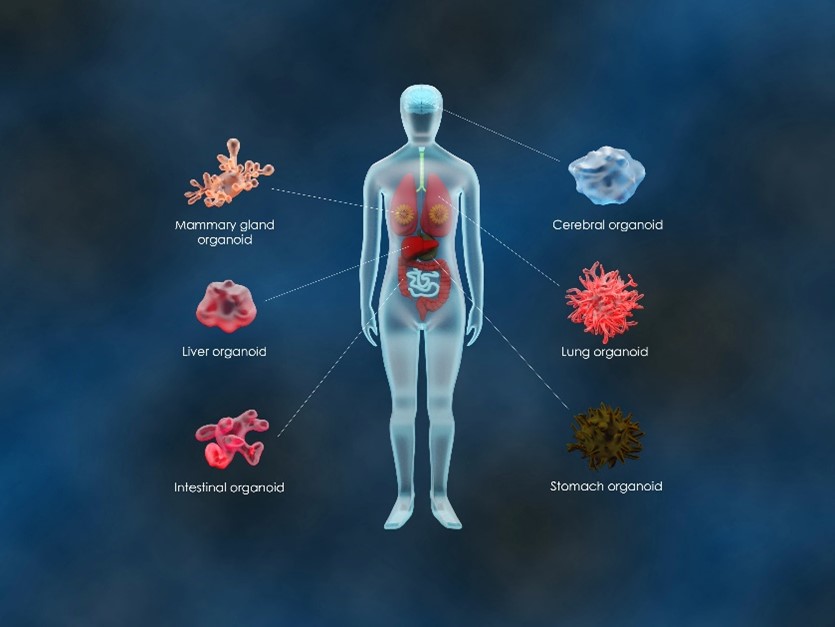Overview of Organoid Research
Organoids are a complex collection of cells grown in a three-dimensional (3D) medium, which are derived from embryonic stem cells (ESC), induced pluripotent stem cells (iPSC), or adult stem cells (ASC). In recent years, it has received more and more attention because of its ability to retain the characteristics of the source organ tissue to a large extent, with a series of advantages such as freeze recovery, long-term culture, wide source, high success rate, short modeling time, and relatively simple culture system.

Generation of Organoids
Organoids are derived from either the directed differentiation of human pluripotent stem cells (hPSCs), tissue-specific adult stem cells, or iPSCs. To create an organoid, scientists embed pluripotent cells in an extracellular matrix, which serves to support the cells. Specific growth factors and proteins that mimic the in vivo environment maintain the stem cell phenotype.
Types of Organoids
-
Brain organoids
The brain is a highly complex organ with elements that are unique to humans. Scientists use mainly hPSCs or mouse embryonic stem cells along with neural stimulatory factors in 3D cell culture protocols. -
Lung organoids
Techniques have since improved as researchers use hPSCs and iPSCs to model airway epithelial cell function, track early lung bud development, and perform lung cancer screens. -
Gastric/intestinal organoids
The gastrointestinal tract has many functions and consists of multiple germ layers that must work together. Researchers have used hPSCs to develop the first intestinal and gastric organoids that contained multiple tissue types. -
Cancer organoids
Patient-derived cancer organoids are an invaluable tool for studying cancer progression. Recently, researchers developed methods to generate and screen patient-derived organoids to determine patient-specific therapies within a matter of days.
Creative Bioarray Relevant Recommendations
- Creative Bioarray developed a protocol that can differentiate brain organoids from iPSCs. We also provide a characterization of iPSC-derived organoids using immunocytochemistry and multi-electrode array (MEA).
Organoid Culture Guide
-
Culture and Expansion of Organoids
Organoids are passaged with a combination of mechanical and enzymatic dissociation. Organoids are typically passaged on a consistent regular schedule driven by size (eg., organoids that become large and make contact with one another within the dome) or indicators of differentiation such as the accumulation of debris within the lumen of the organoid.
| Step | Description |
|---|---|
| ECM removal and washing | The first step in passaging organoids is to remove as much ECM as possible via mechanical breakup of the domes and washing with the basal medium. The more domes that are processed within a single tube, the more difficult it can be to remove the ECM, and more washing steps are typically required. |
| Organoid dissociation and washing | Following ECM removal, organoids are dissociated into single cells or fragments. Some models may only require mechanical disruption, while others may only require enzymatic dissociation. Some models may require both methods. |
| Seeding organoids | After dissociation, single cells or multicellular fragments are re-suspended in fresh ECM and dispensed back into culture vessels as 3-D domes. Seeding multiple small culture vessels is typically easier than seeding larger vessels. |
-
Cryopreservation of Organoids
Organoids are typically cryopreserved at the same point in a culture that they would otherwise be passaged. Organoids are cryopreserved intact, in fragments, or as dissociated cells. Because generating a single cell suspension to obtain accurate cell counts is incompatible with cryopreservation of intact or partially dissociated organoids, individual wells of a 6-well plate of organoids can be collected, dissociated, and counted to predict the cell number contained in larger vessels cultured in parallel.
Applications of Organoids
-
Developmental biology
Mature organoids are capable of displaying functional organ substructures, and they have been used to study adult tissue homeostasis and embryonic organ development. -
Disease models
Similar in function and structure to in vivo organs, organoids can also be used to model pathogenic processes, including infectious, genetic, and degenerative diseases. On the one hand, organoid models overcome some of the research limitations of animal models; on the other hand, they provide a platform for modeling embryonic development and pathology of adult tissues. -
Drug toxicity and efficacy testing
The possibility to test the efficacy and toxicity of drugs against representative targets/organs (gut, liver, and kidney) could potentially limit the ethical issues associated with animal usage. -
Regenerative medicine
Transplantation of organoids derived from the adult stem cells aids in replacing the damaged organ or tissue.

Your email address will not be published. Required fields are marked *